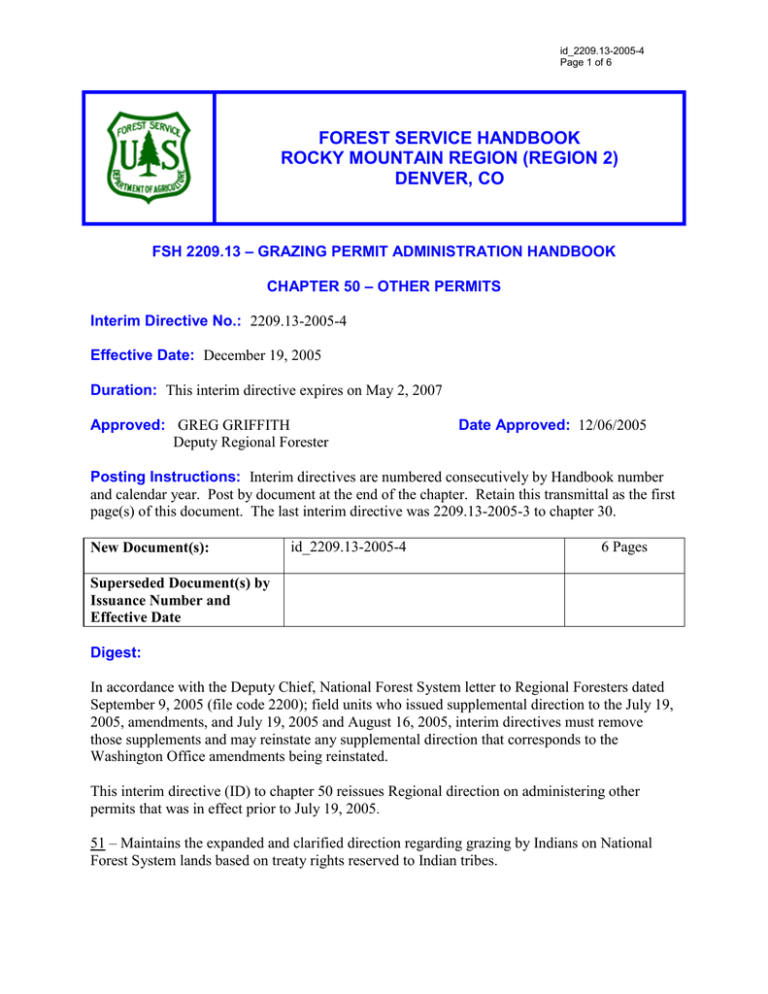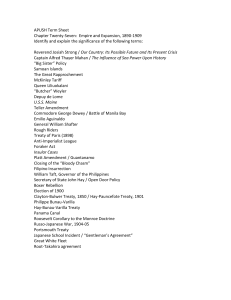
id_2209.13-2005-4
Page 1 of 6
FOREST SERVICE HANDBOOK
ROCKY MOUNTAIN REGION (REGION 2)
DENVER, CO
FSH 2209.13 – GRAZING PERMIT ADMINISTRATION HANDBOOK
CHAPTER 50 – OTHER PERMITS
Interim Directive No.: 2209.13-2005-4
Effective Date: December 19, 2005
Duration: This interim directive expires on May 2, 2007
Approved: GREG GRIFFITH
Deputy Regional Forester
Date Approved: 12/06/2005
Posting Instructions: Interim directives are numbered consecutively by Handbook number
and calendar year. Post by document at the end of the chapter. Retain this transmittal as the first
page(s) of this document. The last interim directive was 2209.13-2005-3 to chapter 30.
New Document(s):
id_2209.13-2005-4
6 Pages
Superseded Document(s) by
Issuance Number and
Effective Date
Digest:
In accordance with the Deputy Chief, National Forest System letter to Regional Foresters dated
September 9, 2005 (file code 2200); field units who issued supplemental direction to the July 19,
2005, amendments, and July 19, 2005 and August 16, 2005, interim directives must remove
those supplements and may reinstate any supplemental direction that corresponds to the
Washington Office amendments being reinstated.
This interim directive (ID) to chapter 50 reissues Regional direction on administering other
permits that was in effect prior to July 19, 2005.
51 – Maintains the expanded and clarified direction regarding grazing by Indians on National
Forest System lands based on treaty rights reserved to Indian tribes.
R2 INTERIM DIRECTIVE
EFFECTIVE DATE: 12/19/2005
DURATION: This interim directive expires on 05/02/2007
id_2209.13-2005-4
Page 2 of 6
FSH 2209.13 – GRAZING PERMIT ADMINISTRATION HANDBOOK
CHAPTER 50 – OTHER PERMITS
Retains requirement for review and coordination with regional rangeland specialist and OGC on
matters concerning interpretation of grazing issues in treaties between United States and Indian
tribes.
Maintains the consolidated and clarified direction in former regarding term grazing permits for
developing ranges on National Forest System lands in the eastern United States.
R2 INTERIM DIRECTIVE
EFFECTIVE DATE: 12/19/2005
DURATION: This interim directive expires on 05/02/2007
id_2209.13-2005-4
Page 3 of 6
FSH 2209.13 – GRAZING PERMIT ADMINISTRATION HANDBOOK
CHAPTER 50 – OTHER PERMITS
Table of Contents
51 - OTHER GRAZING AUTHORIZATIONS .................................................................. 4
51.1 - Grazing Permits Issued to Indian Tribes in Recognition of Treaty Rights ...................... 4
51.11 – Nature of Treaty Rights............................................................................................. 4
51.12 – Scope of Treaty Rights ............................................................................................... 4
51.13 – Treaty Right Beneficiaries ......................................................................................... 4
51.14 – Extent of Treaty Right on National Forest System Land ........................................... 5
51.15 – Grazing Reductions on National Forest System Land ............................................... 5
51.16 – No Fees Charged for Tribal Exercise of Reserved Treaty Rights............................. 5
51.17 – Grazing by Tribes and Native Americans on National Forest System lands not
Subject to Reserved Treaty Rights .............................................................................. 5
51.18 – Internal Review and Coordination ............................................................................. 5
51.2 – Incidental Grazing Authorized by Special Use Permit .................................................... 6
51.3 - Term Grazing Permits for Developing Ranges in the Eastern United States ................... 6
R2 INTERIM DIRECTIVE
EFFECTIVE DATE: 12/19/2005
DURATION: This interim directive expires on 05/02/2007
id_2209.13-2005-4
Page 4 of 6
FSH 2209.13 – GRAZING PERMIT ADMINISTRATION HANDBOOK
CHAPTER 50 – OTHER PERMITS
51 - OTHER GRAZING AUTHORIZATIONS
51.1 - Grazing Permits Issued to Indian Tribes in Recognition of Treaty Rights
Some National Forest System lands originally came into federal ownership as a result of treaties
negotiated with Indian tribes which ceded certain land to the United States in return for the
designation of other land as a permanent reservation for the tribes. In some treaties, Indian tribes
reserved certain rights in the ceded land. One type of “off-reservation right” identified in some
treaties involves the grazing or pasturing of livestock. Sometimes these treaty rights were
reserved exclusively to the tribe; in other situations the rights were reserved to the tribe “in
common with” other non-Indian users. Some treaties refer specifically to grazing on the ceded
land; in other cases, treaties refer specifically to grazing on “unclaimed land.” Ambiguities in
treaty language are typically resolved by courts in favor of the Tribes.
Where an Indian tribe’s claim of treaty rights involve grazing on National Forest System land, it
is imperative for the authorized officer to carefully review the specific language of the treaty.
Where the treaty reserves grazing on “unclaimed lands” it is necessary to identify the location of
these lands and determine whether the Indian tribe or its members were grazing livestock in this
area at the time of the treaty.
It is desirable to enter into a memorandum of understanding with an Indian tribe where offreservation treaty rights involving grazing on National Forest System lands are involved so that
all the parties mutually understand and agree to their respective rights and responsibilities. Nonindian permittees who may be affected by such a memorandum of understanding should be
notified of this endeavor and be allowed to participate where appropriate.
51.11 – Nature of Treaty Rights
Where expressly reserved by treaty, tribal grazing shall be recognized as a reserved right on
National Forest System land held in perpetuity by the Indian tribe.
51.12 – Scope of Treaty Rights
The scope of a reserved treaty right is defined by the specific language in the treaty. In some
instances the treaty may restrict grazing to the lands ceded to the United States; in other
instances, the treaty may have reserved grazing to “unclaimed land.”
51.13 – Treaty Right Beneficiaries
The only party that can claim the reserved right to graze on NFS land under a treaty with the
United States is the tribe with whom that treaty was originally negotiated. Once the scope of the
treaty rights is determined, the tribe will determine how to allocate the grazing among its
R2 INTERIM DIRECTIVE
EFFECTIVE DATE: 12/19/2005
DURATION: This interim directive expires on 05/02/2007
id_2209.13-2005-4
Page 5 of 6
FSH 2209.13 – GRAZING PERMIT ADMINISTRATION HANDBOOK
CHAPTER 50 – OTHER PERMITS
enrolled members. Under no circumstances may the tribe allocate grazing reserved under a
treaty to non-members.
51.14 – Extent of Treaty Right on National Forest System Land
While an Indian tribe may be the beneficiary of treaty rights to graze on some National Forest
System lands by virtue of a treaty with the United States, it is the responsibility of the authorized
officer to determine how the grazing will be exercised. If an Indian tribe is unable or unwilling
to exercise the full extent of its treaty right through the issuance of permits to tribal members, the
authorized officer may issue a term grazing permit to another that is non-Indian, user who
satisfies the requisite eligibility and qualification requirements set forth in chapter 10.
51.15 – Grazing Reductions on National Forest System Land
In the event that the authorized officer determines that a reduction in grazing on National Forest
System lands where treaty rights are involved is warranted, the allocation of reductions may be
handled differently depending on whether the rights in the treaty were reserved exclusively by
the Indian tribe or “in common with” other, non-Indian, users.
Where the treaty rights are the subject of an exclusive reservation in the treaty, the authorized
officer shall first reduce permits issued outside of the treaty. Reductions to permits issued
pursuant to the reserved treaty rights will only be taken when reductions to all other grazing
permits are inadequate to accomplish legal or resource management objectives.
Where, however, the treaty rights were reserved by the Indian tribe in common with other, nonIndian users, the authorized officer shall allocate reductions to accomplish the legal or resource
management objective proportionately among all the permit holders regardless of whether the
permit was issued in recognition a treaty right.
51.16 – No Fees Charged for Tribal Exercise of Reserved Treaty Rights
The authorized officer shall not charge a fee for an Indian tribe exercising its treaty right to graze
on National Forest System lands.
51.17 – Grazing by Tribes and Native Americans on National Forest System lands
not Subject to Reserved Treaty Rights
Where National Forest System lands are not subject to reserved treaty rights the authorized
officer shall administer permits issued to Indians in accordance with the same policies and
procedures that apply to permits issued to non-Indians.
51.18 – Internal Review and Coordination
R2 INTERIM DIRECTIVE
EFFECTIVE DATE: 12/19/2005
DURATION: This interim directive expires on 05/02/2007
id_2209.13-2005-4
Page 6 of 6
FSH 2209.13 – GRAZING PERMIT ADMINISTRATION HANDBOOK
CHAPTER 50 – OTHER PERMITS
Since the issue of Indian tribal rights on NFS land is a highly specialized field and since most of
the Indian treaties are more than 100 years old, authorized officers should consult with their
regional rangeland management specialist and the Office of the General Counsel before making
any decisions regarding the scope and extent of treaty rights an Indian tribe may rightfully claim
under a treaty with the United States.
51.2 – Incidental Grazing Authorized by Special Use Permit
In limited circumstances, special use permits may authorize the use of forage as incidental to the
primary use or activity authorized by the permit. For example, a special use permit issued for an
outfitter and guide operation may include a provision for the use of forage by the pack and
saddle stock utilized by the permit holder as part of his or her operation.
51.3 - Term Grazing Permits for Developing Ranges in the Eastern United States
Application for term grazing permits for developing ranges on national forests in the eastern
United States must be made on Form FS-2200-16, Application for Term Grazing Permit. Issue
the permit on Form FS-2200-10, Term Grazing Permit. However, because developing ranges on
national forests in the eastern United States require special consideration, it may be necessary for
the authorized officer to modify some of the terms and conditions in the standard application and
permit forms by deleting those that are inapplicable.
Include an approved allotment management plan as part of a term grazing permit for developing
ranges that identifies needed structural and nonstructural range improvements. The authorized
officer should establish the initial term of the permit based upon the amount of time, up to ten
years, necessary to implement the range improvements identified in the allotment management
plan. Upon completion of the range improvements, cancel the term grazing permit (developing
ranges) and issue a regular term grazing permit. Refer to chapter 80, for the appropriate grazing
fees to charge after the development phase.
Issue grazing permits for developing ranges in accordance with direction in chapter 10 of this
Handbook except that ownership of base property and permitted livestock is not required during
the initial term of the permit. In addition, the fee for grazing on developing ranges on national
forests in the eastern United States may be waived if the authorized officer determines that any
of the following apply:
1. There is a substantial “start up” cost to the permittee associated with construction of
needed rangeland improvements on the developing range.
2. Forage is available and should be harvested but no one has applied for a permit.
3. The primary objective of the activity is to manage or control vegetation rather than to
graze livestock.



